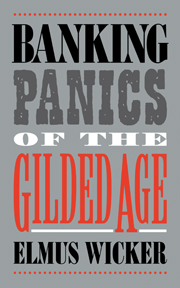Book contents
- Frontmatter
- Contents
- Preface
- 1 The Bank Panic Experience: An Overview
- 2 The Banking Panic of 1873
- 3 Two Incipient Banking Panics of 1884 and 1890: An Unheralded Success Story
- 4 The Banking Panic of 1893
- 5 The Trust Company Panic of 1907
- 6 Were Panics of the National Banking Era Preventable?
- 7 Epilogue
- Appendix
- References
- Index
Preface
Published online by Cambridge University Press: 21 October 2009
- Frontmatter
- Contents
- Preface
- 1 The Bank Panic Experience: An Overview
- 2 The Banking Panic of 1873
- 3 Two Incipient Banking Panics of 1884 and 1890: An Unheralded Success Story
- 4 The Banking Panic of 1893
- 5 The Trust Company Panic of 1907
- 6 Were Panics of the National Banking Era Preventable?
- 7 Epilogue
- Appendix
- References
- Index
Summary
Mark Twain (1873) coined the phrase “The Gilded Age” to dramatize the foibles and excesses of the post–Civil War generation. His portrait of Colonel Sellers was an archetype for a generation of dreamers, panglossian optimists, and tireless promoters who pinned their hopes on gaining a speedy fortune by exploiting the opportunities of an ever expanding frontier.
Twain had in mind particularly the excesses of the Grant administration, and historians were slow to perceive a wider application. The Gilded Age is now one label for the era between the Civil War and the fin de siècle, though the terminal date has remained fuzzy. I have taken the liberty to extend it even further to include the 1907 panic because of the special role financiers, especially J. P. Morgan and his banking associates, played in its containment and the adamant refusal of the New York Clearing House bankers to subordinate their individual self-interest to the public good.
Frenzied railroad building ahead of demand represented speculative excess and was an important contributing cause of the panic of 1873. However, the 1893 panic cannot so easily be identified with speculation and speculative excesses on the part of individual bankers. Nevertheless, the banking panics of the post–Civil War era were not events separate and distinct from the forces shaping the behavior of society and the economy as a whole. And the Gilded Age captures perhaps as well as any other label what some of its characteristic features were.
- Type
- Chapter
- Information
- Banking Panics of the Gilded Age , pp. xi - xviiiPublisher: Cambridge University PressPrint publication year: 2000

